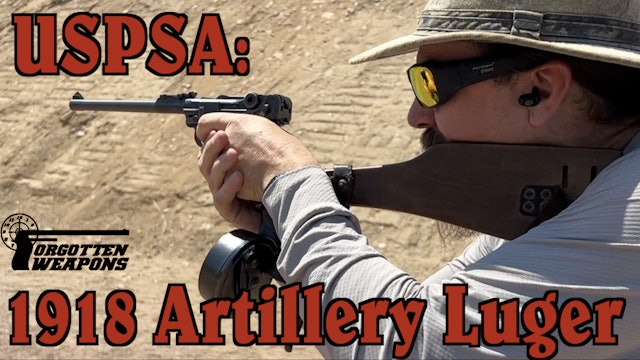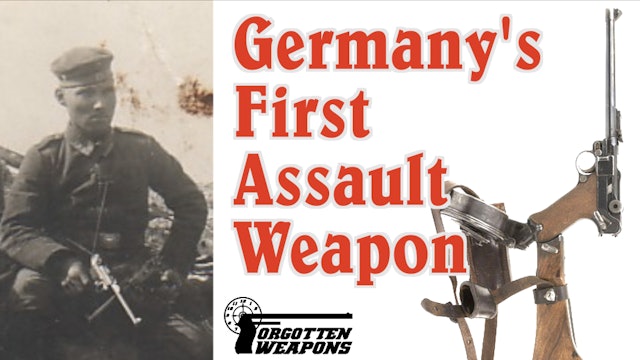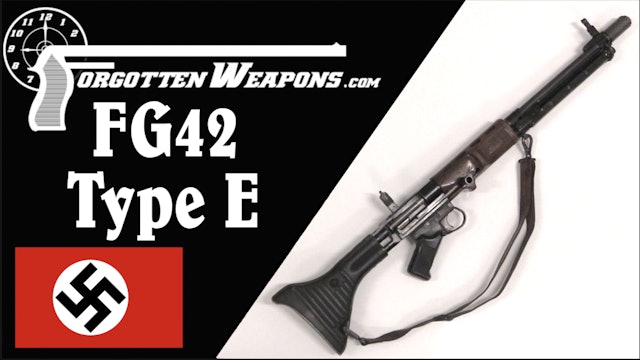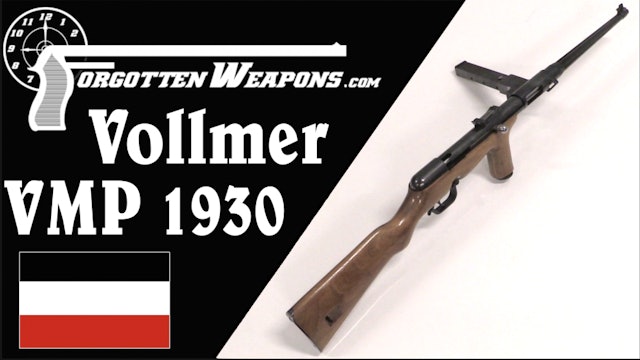-
The FG-42 as a Sniper Rifle?
The FG-42 was specifically made with a scope attachment on every rifle, and intended to serve as a marksman's or sniper's rifle. But how much of that actually happened during World War Two? And was the FG-42 actually suited to a sniper role?
-
An Interesting Possibility: The FG-42 in 8x33mm Kurz?
Here's an interesting thought - what if they made the FG-42 in 8x33mm Kurz? Well, they actually did, in very small numbers. The rifle's designer, Louis Stange, actually thought it was a really good idea, and the Heereswaffenamt office converted a handful of first model FG42s for testing, although...
-
ZF-41: Germany's Worst Sniper Scope
One of the pieces of feedback the German military got from the invasion of Poland in 1939 was a desire for a squad-level designated marksman in each unit. This would be a man with the best shooting skills of the unit, but not actually a fully trained sniper, and he should be equipped with a light...
-
German World War One Gewehr 98 Sniper
Germany was the earliest adopter of scoped rifles in World War One, and produced more of them over the course of the war than any other power. After an initial stop-gap effort to scrounge up civilian hunting rifles, a sniper conversion program was adopted by the main German rifle factories. Germa...
-
Deckungszielgerät - Germany's WW2 Trench Rifle System
When the German attack into Russia stagnated in late 1942, some areas of the front returned to a trench-and-sniper sort of warfare that was reminiscent of World War One. The German military actually went so far as to design and issue a periscopic tech rifle mount, the “deckungszielgerät” (DZG). S...
-
Ian Fangirls Over Some Weird Bergmann (Prototype M1910)
This unique Bergmann Model 1910 was made by Anciens Etablissements Pieper with a grip angled slightly back compared to the standard model. It was also fitted with a square front sight and square rear notch in place of the standard barleycorn style sights. Its serial number (8800) puts it right in...
-
Mauser 1912/14: Flapper-Delayed Blowback
Starting in 1909, Mauser had a plan to introduce a family of automatic pistols, with a picket gun in 6.35mm (.25 ACP) and a military/police service pistol in 9mm Parabellum that shared the same basic look. The initial 1909 prototype in 9mm was simple blowback, and proved to be a failure. The next...
-
Fritz Mann Model 1921: Chamber-Ring-Delayed Blowback
In 1920, Fritz Mann of Germany patented the idea of cutting a shallow ring in the chamber of a pistol as a delaying mechanism. When fired, a cartridge case would expand into this groove, thus requiring more time and energy to push the case out of the chamber and effectively delaying opening. This...
-
1930s German Rearmament: JP Sauer's Pre-K98k Rifle
When the German Army announced in 1934 that it would be adopting a new standard rifle, the JP Sauer company jumped at the chance to submit a model for consideration. Auger has a complete production line for the Mauser pattern rifles, having produced Gewehr 98s during World War One, and it had acc...
-
East Germany's Secret Walther Clone: The Pistole 1001-0
When the Allies occupied German at the end of World War Two, the Walther factory at Zella Mehlis was initially garrisoned by American soldiers (who did a pretty thorough job liberating all the guns they could find there) but eventually ended up in the Soviet occupation zone (and later East German...
-
USPSA with a 105-Year-Old Artillery Luger Rig
Today I'm taking an original (made in 1918) Artillery Luger rig out to a 6-stage USPSA match. I'm entered in PCC (pistol-caliber carbine) division using the detachable shoulder stock (note that this is exempted from the NFA, so it does not need to be registered) and the snail drum magazine. Happi...
-
The First German Assault Weapon: The Lange Pistole 08
The Lange Pistole 08 (long pistol), or Artillery Luger as it is commonly known today, has an interesting history. It was originally developed as a personal defense weapon for German field artillery and air crews. While the foot artillery had been issued carbines, the field artillery were mounted ...
-
Last Gasp of the German Maxim: the Air-Cooled MG 08/18
The MG 08/18 was developed at the very end of World War One as a lighter alternative to the MG 08/15. It used an air-cooled barrel, and between not needing water and having lighter parts it managed to be about 6 pounds less weight than the 08/15. Only a few hundred appear to have been produced be...
-
Rheinmetall MG42/59: The Slow-Fire Commercial MG42
After World War Two, when West Germany was allowed to reconstitute its army and join NATO, it needed small arms. The new Bundeswehr chose the MG42 as it’s standard GPMG, and the Rheinmetall firm undertook the project of recreating the technical data package to build them. The work was completed i...
-
Germany Adopts the PPSh in 9mm: the MP-41(r)
During World War Two, both German and Russian soldiers often thought that the other side's weapons were better than their own. In particular, both sides often preferred their opponents' SMGs. In late 1941, a group of German officers formally requested that Germany simply copy and produce the PPSh...
-
Germany's L26 Silencer for the K98k, G43, and StG44
Patented in Germany as System Schätzle, the L26 was a departure from the copies of the Russian wipe-based silencer designs. The L26 used a set of six identical cone-shaped metal baffles inside a simple tube. It attached to a rifle by clamping around the front sight, just like the rifle grenade la...
-
Germany Copies the Soviets: L23 & L27 Silencers
The German L23 silencer was essentially a copy of captured Soviet Bramit silencers, complete with the attachment system locking around a rifle front sight. Two hundred of these made for the K98k rifle for German trials. These resulted in a desire for a better attachment method, and this led to th...
-
Lugers Under Versailles: The 1926 Simson P08
Simson & Co of Suhl was chosen as the sole contractor legally allowed to manufacture and rework military small arms for the German military under the Versailles treaty. They acquired the P08 Luger tooling from the Erfurt arsenal, and began small volume P08 production in 1925. They would product j...
-
MG-3: Germany Modernizes the Classic MG-42
When the Bundeswehr was formed, it chose to simply continue using the MG42 as its standard GPMG. This was initially done by converting older MG42s to 7.62x51mm NATO as the MG1 (adopted in 1958), but progressed to production of a brand new version of the gun by Rheinmetall (adopted in 1968). The M...
-
"Alk" - A Unique German Target Pistol
This is a unique and interesting German proofed .22 rimfire target pistol. It uses a simple blowback slide, which locks open after each shot. It is striker fired, with a 12-inch barrel and a quite nice trigger. The top of the receiver is marked “Alk” in a fancy script engraving, and also has a pa...
-
Adenauer's Zipper: the Bundeswehr MG-3 at the Range
When the Bundeswehr chose its small arms after World War Two, it saw non reason to move away from the iconic MG-42...but the new weapons needed to be in NATO standard calibers. And so the MG-3 was born: an MG-42 improved in several small ways and rechambered for the 7.62x51mm NATO round. Today we...
-
FG-42: Perhaps the Most Impressive WW2 Shoulder Rifle
The first production version of the FG42 used a fantastically complex milled receiver and a distinctive sharply swept-back pistol grip. A contract to make 5,000 of them was awarded to Krieghoff in late spring of 1943, but by the fall its replacement was already well into development. The milled r...
-
SMG With a Monopod? The Vollmer VMP-1930
In 1925, the German military began a series of secret SMG trials at the Kummersdorf testing grounds. One of the participants was Heinrich Vollmer. He was funded directly by the government for his small arms R&D until 1930, and iteratively developed his design until it went into large-scale produc...
-
VMP 1930 at the Range: does the Monopod Help?
Yesterday we took a look at the mechanics and history of Heinrich Vollmer's 1930 pattern VMP, and today we have it out at the range. I'm curious is the mid-point monopod will actually help or hinder accurate shooting...shall we find out?

























